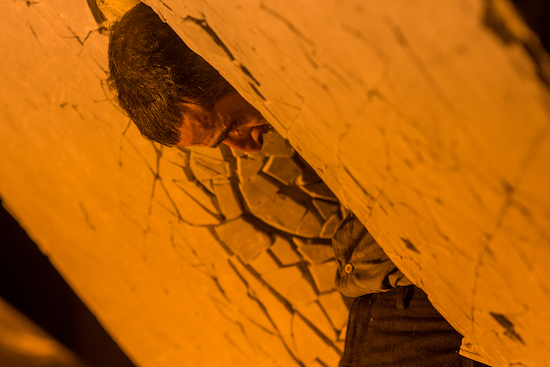In our collective imagination, the focus of the myth of Sisyphus is his endless task of rolling a large rock to the top of a mountain only to have it roll back down every time. Less attention is paid to the unscrupulous figure of King Sisyphus himself, perhaps because it would be harder to pity him, harder to see the myth as a metaphor for life’s inherent absurdity, as Camus saw it. Dimitris Papaioannou’s Sisyphus / Trans / Form, performed from 24th to 27th October at Collezione Maramotti, may not have had the powerful empathetic force it did were there any sense his characters weren’t hapless individuals on the verge of breaking under their burden.
For it’s an especially visceral presentation of Sisyphus’ labour that Papaioannou stages in the old Max Mara building that now holds the Collezione Maramotti. The action took place amongst the works of artists like Mark Manders, covered in polythene sheets, which temporarily transformed the space back into the factory floor it once was. According to Sara Piccinini, Collezione Maramotti’s senior coordinator, Papaioannou is the only commissioned artist to have chosen this particular space alone to exhibit his work. “Many of the previous dancers chose the big room with Claudio Parmiggiani ‘s [Caspar David Friedrich] because [the piece] is very suggestive, suspended in the air above your head, but Dimitris is the first to concentrate everything in this open space on the second floor.”
Even the smallest sense of incongruence that might be felt watching a performance piece in this art gallery is obliterated by the harmony between the work’s theme and the building’s history as a place of manual labour. Here, says Piccinini, visual art and dance which may seem like two different languages “enter into a relationship”. It’s for this reason Collezione Maramotti, who have been collaborating with dance and theatre companies since 2009, seek out choreographers who have a “great sensitivity for visual art.” Papaioannou is the embodiment of this: he trained in fine arts, first attracting critical attention as an illustrator and comic book artist before becoming a renowned choreographer and stage director.
The barrier between “stage” and audience is dissolved in a way that’s both thrilling and uncomfortable. The constant movement of the performers around the space means at times we are forced to follow in order to see and at other times forced to manoeuvre ourselves to avoid colliding with them. The performers, dressed in dark suits covered in dust, are subordinate to Papaioannou’s dispassionate taskmaster but the dust on his own jacket suggests he was once in their position. He observes and guides the performers as they drag the rock with the semi-detached, slightly haughty manner of a recently appointed supervisor.
Papaioannou has often drawn from Greek myth in his work, most notably perhaps in his direction of the opening and closing ceremonies of the 2004 Summer Olympics in Athens, but the effect here is something Beckettian. After a stint dragging the rock, one performer tries to crawl through the hole in it to the other side as another performer simultaneously tries to climb through. Each new arrival takes up the role of the previous Sisyphus but there is never any sense of triumph after the struggle. After a particularly long and wild tussle, one performer sits on the floor, exhausted and seemingly bewildered. He stands up and immediately tries to climb back through the wall, the first person so far not to immediately begin dragging it. But there is no escape, he must return and get to work. He is pouring sweat before an arm comes through dragging him back through the hole to take his place as if to say while this bad, what’s on the other side is immeasurably worse.
At times the uniform made the performers look less like salarymen and more like silent movie characters. In fact, there was something a little Buster Keaton-esque about the bewilderment each performer would show after they made it through the wall, as if they had just come out of a trance. This sense of morbid slapstick became even more pronounced when a performer is symbolically castrated by Papaioannaou, who snatches a tied-up water balloon out of his trousers, then crushed by the wall, his two black shoes sticking out from underneath.
Other moments of startling offbeat humour come when momentarily the tangled limbs of the performers stop thrashing and seem to align, creating the illusion of one figure out of the two bodies, an image that appears in other works by Papaioannou such as 2016’s Since She.
When a woman appears through the hole, wearing not a suit but a light pink slip dress reminiscent of the dancers in Pina Bausch’s Rite of Spring (a choreographer inspirational to Papaioannou), the illusion is more spider-like and threatening, a sensation heightened by the performer stripping the other of his suit as she climbs through, before putting on his clothes and acquiring his balls, to take his place.
While the woman works, the male performer has a new, but just as pointless task: he must hold floorboards against the wall with his body. We see the strain in the muscles, see his naked back become gradually shiner with sweat. But you also notice no one’s paying any attention to the woman – and I include the audience in this. We have all moved on, watching the other male performers take off the singular Sisyphus’ clothes humiliating him, those who were once workers now taskmasters.
Papaioannou’s interpretation of the story seems to move us away from the larger philosophical idea of the Sisyphean and aims to make more visceral the sheer amount of effort involved by focusing on the physical body, the straining muscles, the dripping sweat. In Sisyphus / Trans / Form we also learn whose physical duress inspires empathy and pity and whose labour is romanticised.


